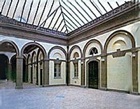

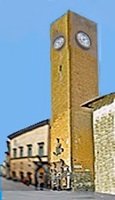
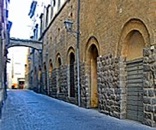
Palace and Torre del Moro Right side of palace
in Corso Cavour in Via della Costituente
Torre del Moro (13th century)
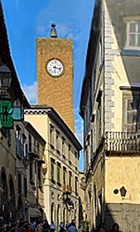
In 1865, the distribution tank of the new waterworks was installed on the roof. In 1875, the present clock replaced the old civic bell. Two new bells were installed in the following year: one of these, which was cast in 1316 and inscribed with the symbols of the 25 guilds that had paid for it, came from Palazzo del Popolo.
It is possible to climb to the top of the Torre del Moro (using the lift for part of the way) for a splendid view of Orvieto and the surrounding countryside. There is a small charge, and access is alternatively included in the price of a “Carta Unica”, which is also available the Tourist Office.
Palazzo dei Signori Sette (ca. 1300-19)
The magistracy known as the Signori Sette, whose seven members were elected for a two-month period by the 25 most important guilds of Orvieto, was constituted in 1292 and originally met in the Palazzo del Popolo. In ca. 1300, Pope Boniface VIII gave the Torre del Moro and adjoining properties to the Commune. This allowed the construction of an L-shaped palace, the Palazzo dei Signori Sette:
-
✴one wing ran along what is now Corso Cavour; and
-
✴the other ran along what is now Via della Costituente, as far as Piazza del Popolo.
The seven magistrates moved here in 1319.
When Cardinal Albornoz abolished the Signori Sette in 1354, the complex reverted to papal ownership. It subsequently fell into ruin, and Pope Leo X gave it back to the Commune in 1515. The Commune then began a programme of regeneration of this important site at the centre of the city.
-
✴In 1523, the derelict part of the complex that faced Piazza del Popolo was used for the construction of San Rocco.
-
✴The commercial properties under the seven arches of the ground floor loggia along what became Via di San Rocco (now Via della Costituente) were rented to shopkeepers.
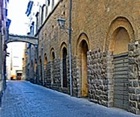
However, further work was stopped as the city concentrated on its defences in the tense period surrounding the sack of Rome (in 1527).
In 1532, the Commune gave the properties along Via della Mercanzia to Antonio da Sangallo il Giovane on condition that he construct a palace there within 10 years. In the event, he did not meet this condition and the site reverted to the Commune.
Work to adapt the complex as the Palazzo del Governatore began in 1553. Raffaello da Montelupo is documented in relation to this work in 1564, and it seems likely that he supervised it over the whole period 1553-64.
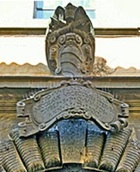
-
✴Orazio Benedetto da Cagli, Governor in 1578;
-
✴Ferrante Ferri, Governor in 1585; and
-
✴Gaspare Paluzzi Albertoni, dated 1598.
The palace was subsequently used for a number of purposes:
-
✴The ground floor was adapted as a new prison in the 17th century.
-
✴The piano nobile became the home of the Accademia dei Risvegliati (Academy of the Awakened) after its reformation in the early 18th century. (This cultural club, which Cardinal Francesco Maria Febei had formed in Palazzo Febei in 1673, had foundered after his death in 1680).
-
✴The palace was the seat of the Tribunale Civile Correzionale (civil courts) from 1831.
